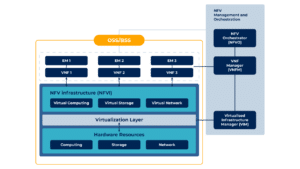IoT Explained
21 January 2022
Reading Time: 3 mins
IoT Explained
21 January 2022
Reading Time: 3 mins

Ian Marsden
Founder & CTO
LinkedInIt’s all in the name: Network Functions Virtualization (NFV) or Virtual Network Function (VNF) is an innovative way to virtualize network functions and services, allowing the user to interact at the server level.
NFV enables mobile network operators (MNOs) to abstract physical resources into virtual resources. This allows MNOs to expand the capabilities of their networks through software-based applications.
Enterprises adopting an NFV approach can accelerate innovation, achieve greater flexibility, and reduce expenditure by collapsing multiple functions into one by replacing network appliance hardware with virtual machines (VM). More enterprises are turning to NFV as it removes the complexity and restraints of managing physical devices, and services can be customised to its needs.
The European Telecommunications Standards Institute (ETSI) brings together an international community of operators, cloud players, manufacturers and IT players who have helped to define NFV standards. They categorise three main components of NFV architecture, namely:

Network orchestration (sometimes referred to as software defined networking) and network functions virtualization have a complementary relationship.
According to ETSI, ‘the former [network orchestration] provides the means to dynamically control the network and the provisioning of networks as a service, the latter [NFV] offers the capability to manage and orchestrate the virtualization of resources for the provisioning of network functions and their composition into higher-layer network services’.
Network orchestration – provides a top-down view of the network infrastructure by decoupling the control plane from the forwarding plane. This enables the provisioning of network services in response to user requirements.
Network functions virtualization – virtualizes network functions and removes them from hardware. Provisioning is more efficient when network functions are handled at the software level.
NFV should be factored into Enterprise IoT projects and network development from the beginning. With NFV, Enterprises can lessen the reliance on hardware and save on both space and power too. This technology empowers Enterprises with the ability to scale at speed while responding to changing network needs. To truly harness the benefits of NFV, it’s advised to pair this approach with network orchestration for flexible IoT deployments.

Ian Marsden
Founder & CTO
LinkedInIan has a passion for developing technology-based solutions that deliver real improvements to businesses, the environment and quality of life.
Previously he co-founded CompXs to deliver the world’s first ZigBee design. Prior to CompXs, Ian held senior software leadership roles at Philips and has since spearheaded the ground-breaking innovation of our global AnyNet Secure cellular solution.